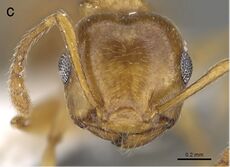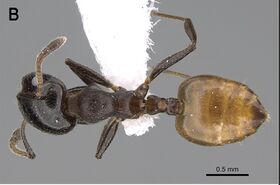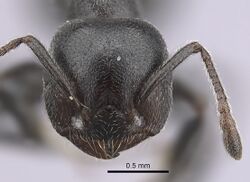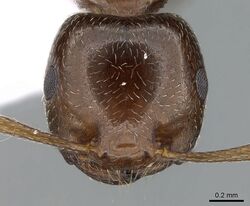Key to Arabian Crematogaster
This key to Crematogaster workers from Arabia is based on Sharaf & Aldawood (2019) as modified by Sharaf & Aldawood (2022).
1
- Postpetiole not bilobed dorsally (Fig. 1A) => Crematogaster gryllsi
- Postpetiole bilobed dorsally (Fig. 1B) => 2
 Sharaf et al 2019. Figure 1. A Postpetiole of C. gryllsi sp. nov. in dorsal view, CASENT0919794 (Michele Esposito) B postpetiole of C. chiarinii in dorsal view, CASENT0263878 (Will Ericson) C propodeum of C. inermis in profile, CASENT0922679 (Wade Lee) D propodeal spines of C. chiarinii in profile, CASENT0263878 (Will Ericson) E mesosoma of C. inermis in profile, KG01956A (Michele Esposito) F mesosoma of C. jacindae in profile CASENT0922856 (Michele Esposito), www.AntWeb.org.
Sharaf et al 2019. Figure 1. A Postpetiole of C. gryllsi sp. nov. in dorsal view, CASENT0919794 (Michele Esposito) B postpetiole of C. chiarinii in dorsal view, CASENT0263878 (Will Ericson) C propodeum of C. inermis in profile, CASENT0922679 (Wade Lee) D propodeal spines of C. chiarinii in profile, CASENT0263878 (Will Ericson) E mesosoma of C. inermis in profile, KG01956A (Michele Esposito) F mesosoma of C. jacindae in profile CASENT0922856 (Michele Esposito), www.AntWeb.org.
2
return to couplet #1
- Propodeal spines completely absent (Fig. 1C) => 3
- Propodeal spines present, ranging from small denticles to long (Fig. 1D) => 4
 Sharaf et al 2019. Figure 1. A Postpetiole of C. gryllsi sp. nov. in dorsal view, CASENT0919794 (Michele Esposito) B postpetiole of C. chiarinii in dorsal view, CASENT0263878 (Will Ericson) C propodeum of C. inermis in profile, CASENT0922679 (Wade Lee) D propodeal spines of C. chiarinii in profile, CASENT0263878 (Will Ericson) E mesosoma of C. inermis in profile, KG01956A (Michele Esposito) F mesosoma of C. jacindae in profile CASENT0922856 (Michele Esposito), www.AntWeb.org.
Sharaf et al 2019. Figure 1. A Postpetiole of C. gryllsi sp. nov. in dorsal view, CASENT0919794 (Michele Esposito) B postpetiole of C. chiarinii in dorsal view, CASENT0263878 (Will Ericson) C propodeum of C. inermis in profile, CASENT0922679 (Wade Lee) D propodeal spines of C. chiarinii in profile, CASENT0263878 (Will Ericson) E mesosoma of C. inermis in profile, KG01956A (Michele Esposito) F mesosoma of C. jacindae in profile CASENT0922856 (Michele Esposito), www.AntWeb.org.
3
return to couplet #2
- Unicolorous yellow-brown to brown species; cephalic surface including area in front of eyes unsculptured; eyes with ca. 14 ommatidia in longest row; posterior half of clypeus with fine appressed pubescence; mesonotum in profile with a small tubercle close to promesonotal suture; mesopleura and metapleura longitudinally striated; mesonotum without hairs; propodeal spiracles circular (Fig. 1E) => Crematogaster inermis
- Bicolored species, head black-brown or black, mesosoma, petiole and postpetiole dark brown, relatively lighter than head, gaster golden yellow; area in front of eyes finely longitudinally striated; cephalic surface feebly imbricate; eyes with ca. 11 ommatidia in longest row; posterior half of clypeus without hairs or pubescence; mesonotum in profile without tubercle; mesopleura and metapleura distinctly densely imbricate; mesonotum with a single pair of hairs; propodeal spiracles slit-shaped, gaster golden yellow (Fig. 1F) => Crematogaster jacindae
 Sharaf et al 2019. Figure 1. A Postpetiole of C. gryllsi sp. nov. in dorsal view, CASENT0919794 (Michele Esposito) B postpetiole of C. chiarinii in dorsal view, CASENT0263878 (Will Ericson) C propodeum of C. inermis in profile, CASENT0922679 (Wade Lee) D propodeal spines of C. chiarinii in profile, CASENT0263878 (Will Ericson) E mesosoma of C. inermis in profile, KG01956A (Michele Esposito) F mesosoma of C. jacindae in profile CASENT0922856 (Michele Esposito), www.AntWeb.org.
Sharaf et al 2019. Figure 1. A Postpetiole of C. gryllsi sp. nov. in dorsal view, CASENT0919794 (Michele Esposito) B postpetiole of C. chiarinii in dorsal view, CASENT0263878 (Will Ericson) C propodeum of C. inermis in profile, CASENT0922679 (Wade Lee) D propodeal spines of C. chiarinii in profile, CASENT0263878 (Will Ericson) E mesosoma of C. inermis in profile, KG01956A (Michele Esposito) F mesosoma of C. jacindae in profile CASENT0922856 (Michele Esposito), www.AntWeb.org.
4
return to couplet #2
- Propodeal spines reduced to a small denticle => Crematogaster delagoensis
- Propodeal spines well developed => 5
5
return to couplet #4
- In full-face view, antennal scapes short, clearly not reaching posterior margin of head (Fig. 2A) => 6
- In full-face view, antennal scapes longer, clearly reaching or surpassing posterior margin of head (Fig. 2B) => 9
 Sharaf et al 2019. Figure 2. A Head of C. aegyptiaca in full-face view, CASENT0916082 (Anna Pal) B head of C. oasium in full-face view, CASENT0249821 (Ryan Perry) C mesosoma of C. aegyptiaca in profile, CASENT0916082 (Anna Pal) D propodeal spines of C. chiarinii in profile, CASENT0263878 (Will Ericson) E head of C. chiarinii in full-face view, CASENT0263878 (Will Ericson) F head of C. mimosae in full-face view,CASENT0904507 (Will Ericson), www.AntWeb.org.
Sharaf et al 2019. Figure 2. A Head of C. aegyptiaca in full-face view, CASENT0916082 (Anna Pal) B head of C. oasium in full-face view, CASENT0249821 (Ryan Perry) C mesosoma of C. aegyptiaca in profile, CASENT0916082 (Anna Pal) D propodeal spines of C. chiarinii in profile, CASENT0263878 (Will Ericson) E head of C. chiarinii in full-face view, CASENT0263878 (Will Ericson) F head of C. mimosae in full-face view,CASENT0904507 (Will Ericson), www.AntWeb.org.
6
return to couplet #5
- Propodeal spines short and blunt, approx. as long as their bases in profile; antennal fossae surrounded by curved striolae in full-face view (Figs. 2A, 2C) => Crematogaster aegyptiaca
- Propodeal spines long and acute, distinctly longer than their bases in profile; antennal fossae surrounded by longitudinal striolae in full-face view (Figs. 2D, 2E) => 7
 Sharaf et al 2019. Figure 2. A Head of C. aegyptiaca in full-face view, CASENT0916082 (Anna Pal) B head of C. oasium in full-face view, CASENT0249821 (Ryan Perry) C mesosoma of C. aegyptiaca in profile, CASENT0916082 (Anna Pal) D propodeal spines of C. chiarinii in profile, CASENT0263878 (Will Ericson) E head of C. chiarinii in full-face view, CASENT0263878 (Will Ericson) F head of C. mimosae in full-face view,CASENT0904507 (Will Ericson), www.AntWeb.org.
Sharaf et al 2019. Figure 2. A Head of C. aegyptiaca in full-face view, CASENT0916082 (Anna Pal) B head of C. oasium in full-face view, CASENT0249821 (Ryan Perry) C mesosoma of C. aegyptiaca in profile, CASENT0916082 (Anna Pal) D propodeal spines of C. chiarinii in profile, CASENT0263878 (Will Ericson) E head of C. chiarinii in full-face view, CASENT0263878 (Will Ericson) F head of C. mimosae in full-face view,CASENT0904507 (Will Ericson), www.AntWeb.org.
7
return to couplet #5
- Body distinctly opaque; cephalic surface completely densely longitudinally rugulose; head, mesosoma, petiole and postpetiole reddish (Fig. 2F) => Crematogaster mimosae
- Body shining; only area in front of eyes faintly longitudinally rugolose; head, mesosoma, petiole and postpetiole uniform yellow or brown => 8
 Sharaf et al 2019. Figure 2. A Head of C. aegyptiaca in full-face view, CASENT0916082 (Anna Pal) B head of C. oasium in full-face view, CASENT0249821 (Ryan Perry) C mesosoma of C. aegyptiaca in profile, CASENT0916082 (Anna Pal) D propodeal spines of C. chiarinii in profile, CASENT0263878 (Will Ericson) E head of C. chiarinii in full-face view, CASENT0263878 (Will Ericson) F head of C. mimosae in full-face view,CASENT0904507 (Will Ericson), www.AntWeb.org.
Sharaf et al 2019. Figure 2. A Head of C. aegyptiaca in full-face view, CASENT0916082 (Anna Pal) B head of C. oasium in full-face view, CASENT0249821 (Ryan Perry) C mesosoma of C. aegyptiaca in profile, CASENT0916082 (Anna Pal) D propodeal spines of C. chiarinii in profile, CASENT0263878 (Will Ericson) E head of C. chiarinii in full-face view, CASENT0263878 (Will Ericson) F head of C. mimosae in full-face view,CASENT0904507 (Will Ericson), www.AntWeb.org.
8
return to couplet #7
- Body uniform yellow; propodeal spine in profile distinctly shorter than its base (Fig. 3A); propodeum dorsum seen from above faintly longitudinally striated (Fig. 3B) => Crematogaster acaciae
- Body Brown-black to black; propodeal spine distinctly longer than its base (Fig. 3C); propodeum dorsum seen from above faintly punctate (Fig. 3D) => 8A
 Sharaf & Aldawood (2022), Figure 3 A–F. Key’s illustrations, (A) Mesosoma in profile of Crematogaster acaciae, CASENT0908494, (Zach Lieberman); (B) Mesosoma in dorsal view of C. acacia, CASENT0908494 (Zach Lieberman); (C) Mesosoma in profile of Crematogaster chiarinii, CASENT0908514 (Will Ericson); (D) Mesosoma in dorsal view of C. chiarinii, CASENT0906371, (Estella Ortega); (E) Mesosoma in profile of Crematogaster ghoneimi, CASENT0746645, (Michele Esposito); (F) Petiole of Crematogaster ghoneimi, CASENT0746645, (Michele Esposito).
Sharaf & Aldawood (2022), Figure 3 A–F. Key’s illustrations, (A) Mesosoma in profile of Crematogaster acaciae, CASENT0908494, (Zach Lieberman); (B) Mesosoma in dorsal view of C. acacia, CASENT0908494 (Zach Lieberman); (C) Mesosoma in profile of Crematogaster chiarinii, CASENT0908514 (Will Ericson); (D) Mesosoma in dorsal view of C. chiarinii, CASENT0906371, (Estella Ortega); (E) Mesosoma in profile of Crematogaster ghoneimi, CASENT0746645, (Michele Esposito); (F) Petiole of Crematogaster ghoneimi, CASENT0746645, (Michele Esposito).
8A
- Promesonotum without hairs (Fig. 3C); propodeal spine in profile nearly twice longer than its base and tapering apically; subpetiolar process present (Fig. 3C) => Crematogaster chiarinii
- Promesonotum with a single pair of hairs (Fig. 3E); propodeal spine in profile distinctly more than three times longer than its base and not tapering apically; subpetiolar process absent (Fig. 3F) => Crematogaster ghoneimi
 Sharaf & Aldawood (2022), Figure 3 A–F. Key’s illustrations, (A) Mesosoma in profile of Crematogaster acaciae, CASENT0908494, (Zach Lieberman); (B) Mesosoma in dorsal view of C. acacia, CASENT0908494 (Zach Lieberman); (C) Mesosoma in profile of Crematogaster chiarinii, CASENT0908514 (Will Ericson); (D) Mesosoma in dorsal view of C. chiarinii, CASENT0906371, (Estella Ortega); (E) Mesosoma in profile of Crematogaster ghoneimi, CASENT0746645, (Michele Esposito); (F) Petiole of Crematogaster ghoneimi, CASENT0746645, (Michele Esposito).
Sharaf & Aldawood (2022), Figure 3 A–F. Key’s illustrations, (A) Mesosoma in profile of Crematogaster acaciae, CASENT0908494, (Zach Lieberman); (B) Mesosoma in dorsal view of C. acacia, CASENT0908494 (Zach Lieberman); (C) Mesosoma in profile of Crematogaster chiarinii, CASENT0908514 (Will Ericson); (D) Mesosoma in dorsal view of C. chiarinii, CASENT0906371, (Estella Ortega); (E) Mesosoma in profile of Crematogaster ghoneimi, CASENT0746645, (Michele Esposito); (F) Petiole of Crematogaster ghoneimi, CASENT0746645, (Michele Esposito).
9
return to couplet #5
- Antennal scapes when laid back from their insertions just reach posterior margin of head in full-face view => 10
- Antennal scapes when laid back from their insertions clearly surpassing posterior margin of head in full-face view => 11
10
return to couplet #9
- Unicolorous brown species; clypeus smooth; anterior half of head in full-face view longitudinally striated, ground surface between striae smooth; posterior half of head smooth, general appearance of head shining (Fig. 3A) => Crematogaster senegalensis
- Bicolored species, head, mesosoma, petiole, postpetiole and appendages brown or red-brown, gaster golden yellow; clypeus longitudinally striated; anterior half of head in full-face view finely longitudinally striated, grown surface between striae and posterior half of head finely densely punctate; general appearance of head dull (Fig. 3B) => Crematogaster flaviventris
 Sharaf et al 2019. Figure 3. A Head of C. senegalensis in full-face view, CASENT0104592 (April Nobile) B head of C. flaviventris in full-face view, CASENT0912651 (Will Ericson) C head of C. melanogaster in full-face view, CASENT0904511 (Will Ericson) D mesosoma of C. melanogaster in profile, CASENT0904511 (Will Ericson) E head of C. auberti in full-face view, CASENT0908480 (Zach Lieberman) F mesosoma of C. auberti in profile, CASENT0904499 (Will Ericson), www.AntWeb.org.
Sharaf et al 2019. Figure 3. A Head of C. senegalensis in full-face view, CASENT0104592 (April Nobile) B head of C. flaviventris in full-face view, CASENT0912651 (Will Ericson) C head of C. melanogaster in full-face view, CASENT0904511 (Will Ericson) D mesosoma of C. melanogaster in profile, CASENT0904511 (Will Ericson) E head of C. auberti in full-face view, CASENT0908480 (Zach Lieberman) F mesosoma of C. auberti in profile, CASENT0904499 (Will Ericson), www.AntWeb.org.
11
return to couplet #9
- Mesonotum in profile without a small tubercle close to promesonotal suture => 12
- Mesonotum in profile with a small tubercle close to promesonotal suture => 13
12
return to couplet #11
- Whole cephalic surface finely, densely longitudinally striated and dull; head in full-face view with antennal scapes surpassing posterior margin of head byapproximate length of the three funicular segments together; propodeal spines long and acute, more than twice longer than bases; mesonotum in profile feebly convex; subpetiolar process well developed; mesosomal hairs numerous, five on promesonotum, two on pronotum, and a single pair on the propodeum (Figs. 3C, 3D) => Crematogaster melanogaster
- Anterior half of cephalic surface superficially striated, posterior half smooth and shining; head in full-face view with antennal scapes surpassing posterior margin of head by ca. thickness of the first funicular segment; propodeal spines shorter and blunt, ca. 1.5× longer than bases; mesonotum in profile strongly convex; subpetiolar process absent; mesosomal hairs restricted to a single pair on pronotum (FigS. 3E, 3F) => Crematogaster auberti
 Sharaf et al 2019. Figure 3. A Head of C. senegalensis in full-face view, CASENT0104592 (April Nobile) B head of C. flaviventris in full-face view, CASENT0912651 (Will Ericson) C head of C. melanogaster in full-face view, CASENT0904511 (Will Ericson) D mesosoma of C. melanogaster in profile, CASENT0904511 (Will Ericson) E head of C. auberti in full-face view, CASENT0908480 (Zach Lieberman) F mesosoma of C. auberti in profile, CASENT0904499 (Will Ericson), www.AntWeb.org.
Sharaf et al 2019. Figure 3. A Head of C. senegalensis in full-face view, CASENT0104592 (April Nobile) B head of C. flaviventris in full-face view, CASENT0912651 (Will Ericson) C head of C. melanogaster in full-face view, CASENT0904511 (Will Ericson) D mesosoma of C. melanogaster in profile, CASENT0904511 (Will Ericson) E head of C. auberti in full-face view, CASENT0908480 (Zach Lieberman) F mesosoma of C. auberti in profile, CASENT0904499 (Will Ericson), www.AntWeb.org.
13
return to couplet #11
- Cephalic surface and clypeus completely finely densely longitudinally striated => Crematogaster striaticeps
- Anterior half of cephalic surface or at least area in front of eyes and clypeus longitudinally striated => 14
14
return to couplet #13
- Promesonotum with at least four pairs of suberect hairs; petiole in dorsal view with pointed anterior corners; first gastral tergite with several pairs of hairs (ca. 7 pairs) => Crematogaster oasium
- Promesonotum with a single pair of hairs or without hairs; petiole in dorsal view with rounded anterior corners; hairs on first gastral tergites rare, restricted to few pairs on posterior margin of the tergite => 15
15
return to couplet #14
- Petiole in dorsal view with concave anterior margin; promesonotum and mesonotum dorsum unsculptured (Fig. 4A) => Crematogaster antaris
- Petiole in dorsal view with a straight anterior margin; promesonotum and mesonotum dorsum distinctly longitudinally striated (Fig. 4B) => 16
 Sharaf et al 2019. Figure 4. Petiole of C. antaris in dorsal view, CASENT0903658 (Will Ericson) B petiole of C. jehovae in dorsal view, CASENT0908475 (Zach Lieberman) C postpetiole of C. laestrygon in dorsal view, CASENT0912691 (Zach Lieberman) D postpetiole of C. jehovae in dorsal view, CASENT0908475 (Zach Lieberman), www.AntWeb.org.
Sharaf et al 2019. Figure 4. Petiole of C. antaris in dorsal view, CASENT0903658 (Will Ericson) B petiole of C. jehovae in dorsal view, CASENT0908475 (Zach Lieberman) C postpetiole of C. laestrygon in dorsal view, CASENT0912691 (Zach Lieberman) D postpetiole of C. jehovae in dorsal view, CASENT0908475 (Zach Lieberman), www.AntWeb.org.
16
return to couplet #15
- Postpetiole approx. twice broader than long in dorsal view; color black-brown or dark brown (Fig. 4C) => Crematogaster laestrygon
- Postpetiole little broader than long in dorsal view; color red-brown (Fig. 4D) => Crematogaster jehovae
 Sharaf et al 2019. Figure 4. Petiole of C. antaris in dorsal view, CASENT0903658 (Will Ericson) B petiole of C. jehovae in dorsal view, CASENT0908475 (Zach Lieberman) C postpetiole of C. laestrygon in dorsal view, CASENT0912691 (Zach Lieberman) D postpetiole of C. jehovae in dorsal view, CASENT0908475 (Zach Lieberman), www.AntWeb.org.
Sharaf et al 2019. Figure 4. Petiole of C. antaris in dorsal view, CASENT0903658 (Will Ericson) B petiole of C. jehovae in dorsal view, CASENT0908475 (Zach Lieberman) C postpetiole of C. laestrygon in dorsal view, CASENT0912691 (Zach Lieberman) D postpetiole of C. jehovae in dorsal view, CASENT0908475 (Zach Lieberman), www.AntWeb.org.
References
- Sharaf, M.R., Aldawood, A.S., Hita Garcia, F. 2019. Review of the Arabian Crematogaster Lund (Hymenoptera, Formicidae), synoptic list, distribution, and description of two new species from Oman and Saudi Arabia. ZooKeys 898: 27–81 (doi:10.3897/zookeys.898.37531).
- Sharaf, M.R., Aldawood, A.S. 2022. Crematogaster ghoneimi, sp. nov., a new ant species (Hymenoptera: Formicidae) from the Kingdom of Saudi Arabia. Annales Zoologici 72(4): 937-943 (doi:10.3161/00034541anz2022.72.4.009).


































